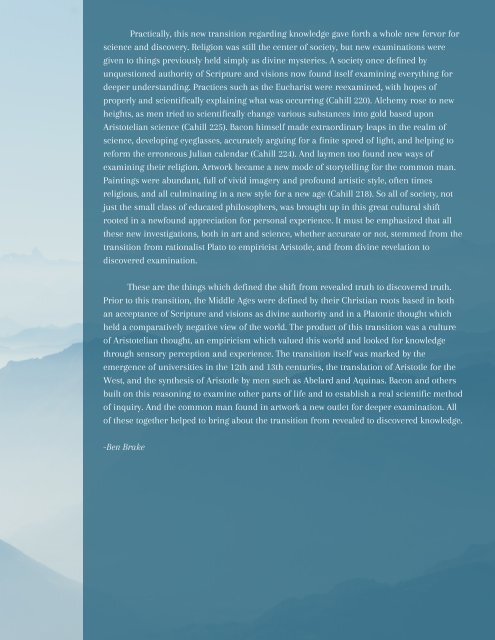Hemispheres 2019
Wichita Collegiate School's literary magazine, Hemispheres. Faculty Sponsor: Barbara Stokley.
Wichita Collegiate School's literary magazine, Hemispheres.
Faculty Sponsor: Barbara Stokley.
You also want an ePaper? Increase the reach of your titles
YUMPU automatically turns print PDFs into web optimized ePapers that Google loves.
Practically, this new transition regarding knowledge gave forth a whole new fervor for<br />
science and discovery. Religion was still the center of society, but new examinations were<br />
given to things previously held simply as divine mysteries. A society once defined by<br />
unquestioned authority of Scripture and visions now found itself examining everything for<br />
deeper understanding. Practices such as the Eucharist were reexamined, with hopes of<br />
properly and scientifically explaining what was occurring (Cahill 220). Alchemy rose to new<br />
heights, as men tried to scientifically change various substances into gold based upon<br />
Aristotelian science (Cahill 225). Bacon himself made extraordinary leaps in the realm of<br />
science, developing eyeglasses, accurately arguing for a finite speed of light, and helping to<br />
reform the erroneous Julian calendar (Cahill 224). And laymen too found new ways of<br />
examining their religion. Artwork became a new mode of storytelling for the common man.<br />
Paintings were abundant, full of vivid imagery and profound artistic style, often times<br />
religious, and all culminating in a new style for a new age (Cahill 218). So all of society, not<br />
just the small class of educated philosophers, was brought up in this great cultural shift<br />
rooted in a newfound appreciation for personal experience. It must be emphasized that all<br />
these new investigations, both in art and science, whether accurate or not, stemmed from the<br />
transition from rationalist Plato to empiricist Aristotle, and from divine revelation to<br />
discovered examination.<br />
These are the things which defined the shift from revealed truth to discovered truth.<br />
Prior to this transition, the Middle Ages were defined by their Christian roots based in both<br />
an acceptance of Scripture and visions as divine authority and in a Platonic thought which<br />
held a comparatively negative view of the world. The product of this transition was a culture<br />
of Aristotelian thought, an empiricism which valued this world and looked for knowledge<br />
through sensory perception and experience. The transition itself was marked by the<br />
emergence of universities in the 12th and 13th centuries, the translation of Aristotle for the<br />
West, and the synthesis of Aristotle by men such as Abelard and Aquinas. Bacon and others<br />
built on this reasoning to examine other parts of life and to establish a real scientific method<br />
of inquiry. And the common man found in artwork a new outlet for deeper examination. All<br />
of these together helped to bring about the transition from revealed to discovered knowledge.<br />
-Ben Brake



